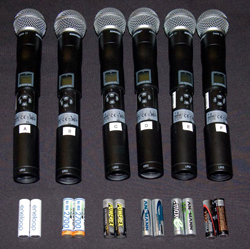One of the most fascinating topics I’ve ever written about has to be rechargeable batteries.
I’ve tweeted about and read countless comment threads on the topic and there seems to be three camps of people in the rechargeable battery debate.
The first group has used them for years, loves them and wouldn’t consider going back to alkaline batteries.
The second group has never used them, though most have heard the horror stories and are leery. The third group has tried them, and had bad experiences.
The phrase, “I’ve been burned too many times, I’ll never trust them,” has been thrown around dozens of times just in the last few weeks. This article is for the second and third groups.
If you’ve been burned, I’m going to explain why, and if you’ve heard the stories, I’ll show you how to avoid them.
By way of introduction, know that I have been using rechargeable batteries in wireless mics (and a lot of other stuff) for almost four years. I’ve tested them, and have gone through hundreds of services using rechargeable batteries without a problem.
Yes, hundreds of services. Far too many people have one bad experience, don’t investigate the cause and swear them off. The fact is, I’ve had just as many ProCells die on me at the wrong time as I have rechargeable cells–and in each case, it was always been my fault—I simply forgot to change them.
There are four things you need to know in order to get the most out of rechargeable batteries. Failing to understand and implement these things will guarantee bad experiences. However, trying to stretch a ProCell for 2 weekends worth of services is a bad idea, too.
Keep in mind that rechargeable batteries behave differently than alkalines. Expecting them to be the same will only frustrate you. However, follow these guidelines and you’ll have great success; and save a ton of money.
Use Good Batteries
This is one of the key factors in getting good results. A lot of people went down to K-Mart 10 years ago, picked up a $10 pack of four NiCd AAs and a charger, tried them in their mics and went down in flames. That explains 50% of the “bad experiences.”
To use rechargeable batteries in wireless mics, you need to use a more modern chemistry, Nickel Metal Hydride, or NiMh. The batteries need to be rated for at least 2000 mAh (I like 2500 and higher). mAh stands for milliamp hours and is provides a guide as to how much energy the battery can store.
If you pull open your junk drawer and find a bunch of 1300 mAh NiMh batteries that are 5+ years old, that may explain the other 50% of the “been burned” statements.
A ProCell is rated for somewhere around 1800 mAh. The modern, high quality batteries from Sanyo, Powerex and Ansmann (with ratings from 2700-2850 mAh) absolutely blow ProCells away; as I’ll show you in an upcoming series of test results.
Even a 4-year old Ansmann 2700 beats a ProCell by almost 4 hours. And these newer batteries are rated for between 500-1000 charge cycles. Figuring one or two cycles a weekend, that could easily mean 5 years or more on one set, provided they are taken care of.
If your experience with rechargeable batteries does not include these newer batteries, you simply don’t have enough experience to make an informed decision.
So good batteries are important, but there is another component.





















